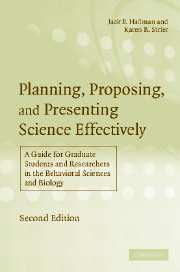 Planning, Proposing, and Presenting Science Effectively
Planning, Proposing, and Presenting Science Effectively 3 - How to write a research report
Published online by Cambridge University Press: 01 September 2010
Summary
There can be no great smoke arise, but there must be some fire, no great report without great suspicion.
John Lyly (c. 1554–1606)Research results are of little use unless they are reported so that others can access them. We have turned “report” of the opening quote into a double entendre in order to make the point that a scientific report should be written clearly so as to avoid suspicion. This chapter deals with writing a research report such as a graduate thesis or a manuscript for publication. The next chapter considers presenting research orally or by a poster paper at a scientific meeting, and Appendix A discusses clarity of writing in general.
Scientific reports have a standard format that should always be followed in the absence of special instructions to the contrary. Here is the usual sequence of parts of a scientific report:
Title page
Abstract
Introduction
Methods
Results
Discussion
(Conclusions)
Acknowledgments
Literature cited
Appendixes
Tables
Figure legends
Figures
Exceptions to this list are uncommon. For example, certain journals may have unusual requirements of style or form that need to be followed in manuscripts. Our advice to always follow exactly the instructions to authors when preparing a report for publication cannot be overstressed. In certain student reports and theses, placing figure legends on the figures themselves and inserting figures and tables as separate pages after their first mention in the text may be permitted. Conclusions may be a separate section (older pattern) or incorporated at the end of the discussion (now more common).
- Type
- Chapter
- Information
- Planning, Proposing, and Presenting Science EffectivelyA Guide for Graduate Students and Researchers in the Behavioral Sciences and Biology, pp. 64 - 107Publisher: Cambridge University PressPrint publication year: 2006


